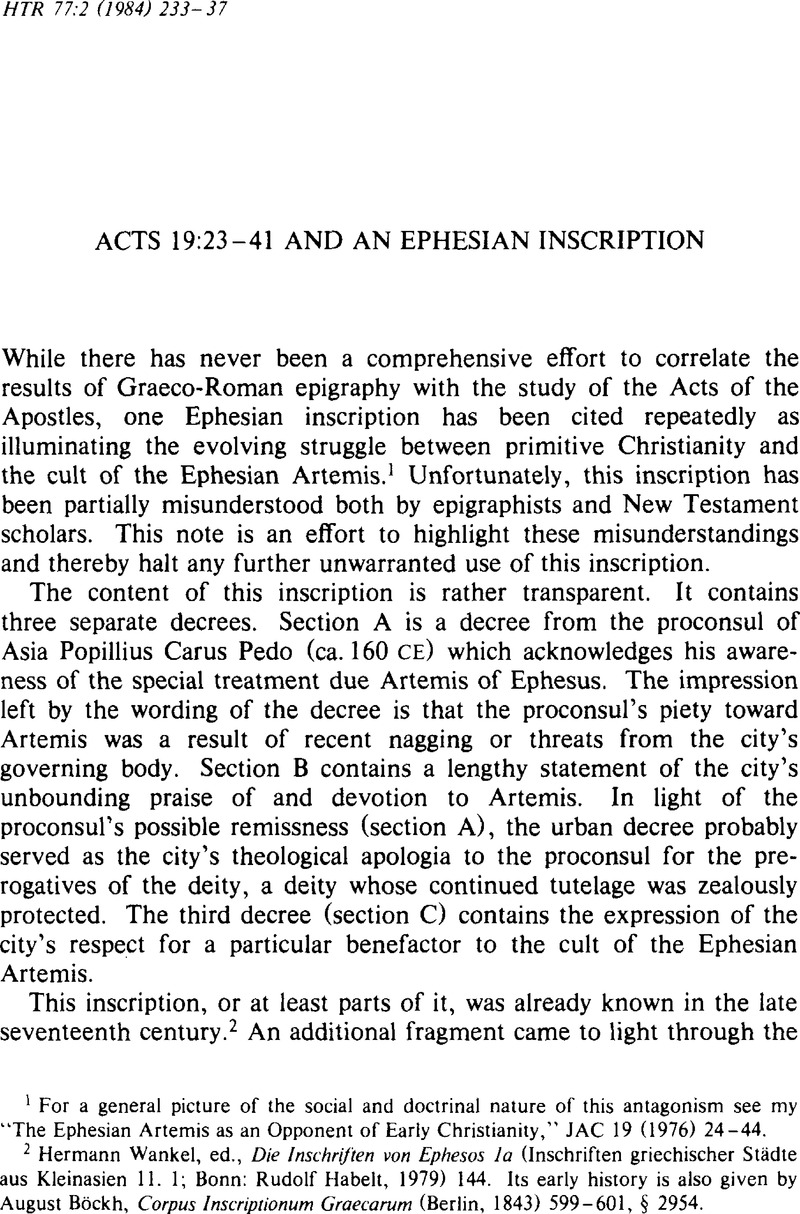Article contents
Acts 19:23–41 and An Ephesian Inscription
Published online by Cambridge University Press: 10 June 2011
Abstract

- Type
- Notes & Observations
- Information
- Copyright
- Copyright © President and Fellows of Harvard College 1984
References
1 For a general picture of the social and doctrinal nature of this antagonism see my “The Ephesian Artemis as an Opponent of Early Christianity,” JAC 19 (1976) 24–44.Google Scholar
2 Wankel, Hermann, ed., Die Inschriften von Ephesos la (Inschriften griechischer Städte aus Kleinasien 11. 1; Bonn: Rudolf Habelt, 1979) 144.Google Scholar Its early history is also given by Böckh, August, Corpus Inscriptionum Graecarum (Berlin, 1843) 599–601, § 2954.Google Scholar
3 Discoveries at Ephesus, Including the Site and Remains of the Great Temple of Diana (London: Longmans, Green, 1877).Google Scholar
4 The Collection of Ancient Greek Inscriptions in the British Museum: Ephesos (Oxford: Clarendon, 1890) 142–45, § 482.Google Scholar
5 Ibid., 144.
6 Ibid., 294.
7 Ibid., 145.
8 Sylloge Inscriptionum Graecarum (2d ed.; Leipzig, 1900) 476, § 656.Google Scholar
9 Mythologisch-Epigraphisches (Beigabe zum Jahresbericht des Wettiner Gymnasiums zu Dresden; Dresden: Teubner, 1910) 30–31.Google Scholar
10 Sylloge Inscriptionum Graecarum (3d ed.; Leipzig, 1917) 579Google Scholar, § 867. Sokolowski, Franciszek (Lois Sacrées de L'Asie Mineure [École Françhise d'Athenes, Fasc. 9; Paris: de Boccard, 1955] 87, § 31) likewise follows Höfer's conclusion.Google Scholar
11 Gasque, W. Ward, A History of the Criticism of the Acts of the Apostles (Grand Rapids: Eerdmans, 1975) 184.Google Scholar
12 In Foakes-Jackson, F. J. and Lake, Kirsopp, eds., The Beginnings of Christianity: The Acts of the Apostles (5 vols.; London: Macmillan, 1933) 5. 251–56.Google Scholar
13 Ibid., 255.
14 Wankel, Inschriften von Ephesos, 148.
15 Ibid.
16 I.K. 11 (Ephesos), 24. The editors of Die Inschriften von Ephesos have suggested this style of abbreviation for the citation of inscriptions from all volumes of Inschriften griechischer Städte aus Kleinasien (I.K. 17 [Ephesos] x).
17 Acts 14:6–18; 17:16–34; 19:23–41; Pliny Letters 10.96–97; Lucian Alexander sive Pseudomantis 25, 38.
18 While Ramsay MacMullen is correct when he cautions against misunderstanding the “vitality of Paganism” (Paganism in the Roman Empire [New Haven: Yale University Press, 1981] 62–73), one need not doubt that there were trends in religious zeal in antiquity. The temple-building fervor of Augustus is a case in point (The Achievements of the Divine Augustus 19–21; appendix). And in the case of this particular episode, the epigraphical data provide no cogent evidence for any Christian involvement in the supposed decline of Artemis worship or the erection of the monument.Google Scholar
- 1
- Cited by


